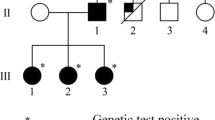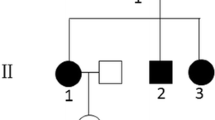Abstract
Cerebral cavernous malformation (CCM) is a congenital vascular anomaly predominantly located within the central nervous system. Its familial forms (familial cerebral cavernous malformation (FCCM)), inherited in an autosomal dominant manner with incomplete penetrance, are attributed to mutations in CCM1/KRIT1, CCM2/MGC4607, and CCM3/PDCD10 genes. To date, little is known about the genetic alterations leading to FCCM in the Chinese population. We aimed to investigate the genetic defect of FCCM by DNA sequencing in Chinese families. This study enrolled five Chinese families with FCCM. All index cases underwent surgical treatment and were diagnosed with CCM by pathology; their relatives were diagnosed based on radiological and/or pathological evidence. Genomic DNA was extracted from peripheral blood and amplified using polymerase chain reaction (PCR) for DNA sequencing. The five families comprised a total of 21 affected individuals: 12 of these were symptomatic, and 9 were asymptomatic. Sequence analyses in the index patients disclosed three heterozygous loss-of-function mutations in the CCM1/KRIT1 gene in three families, respectively: a novel deletion mutation (c.1780delG; p.Ala594HisfsX67) in exon 16, a novel splice-site mutation (c.1412-1G>A) in the splice acceptor site in intron 13, and a previously described 4-bp deletion (c.1197_1200delCAAA; p.Gln401ThrfsX10) in exon 12. All of these mutations are predicted to cause a premature termination codon to generate a truncated Krev interaction trapped 1 (Krit1) protein. These mutations segregated in affected relatives. Our findings provided new CCM1 gene mutation profiles, which help to elucidate the pathogenesis of FCCM and will be of great significance in genetic counseling.



Similar content being viewed by others
References
Balasubramanian M, Jain V, Glover RC, Robertson LK, Mordekar SR (2013) Cerebral cavernous malformation: clinical report of two families with variable phenotype associated with KRIT1 mutation. Eur J Paediatr Neurol 17:661–665. doi:10.1016/j.ejpn.2013.05.003
Bulut HT, Sarica MA, Baykan AH (2014) The value of susceptibility weighted magnetic resonance imaging in evaluation of patients with familial cerebral cavernous angioma. Int J Clin Exp Med 7:5296–5302
Chen DH, Lipe HP, Qin Z, Bird TD (2002) Cerebral cavernous malformation: novel mutation in a Chinese family and evidence for heterogeneity. J Neurol Sci 196:91–96
Cigoli MS et al. (2014) PDCD10 gene mutations in multiple cerebral cavernous malformations. PLoS One 9:e110438. doi:10.1371/journal.pone.0110438
Craig HD et al. (1998) Multilocus linkage identifies two new loci for a mendelian form of stroke, cerebral cavernous malformation, at 7p15-13 and 3q25.2-27. Hum Mol Genet 7:1851–1858
D’Angelo R et al. (2011) Mutation analysis of CCM1, CCM2 and CCM3 genes in a cohort of Italian patients with cerebral cavernous malformation. Brain Pathol (Zurich, Switzerland) 21:215–224. doi:10.1111/j.1750-3639.2010.00441.x
de Souza JM, Domingues RC, Cruz LC Jr, Domingues FS, Iasbeck T, Gasparetto EL (2008) Susceptibility-weighted imaging for the evaluation of patients with familial cerebral cavernous malformations: a comparison with t2-weighted fast spin-echo and gradient-echo sequences. AJNR Am J Neuroradiol 29:154–158. doi:10.3174/ajnr.A0748
Denier C et al. (2006) Genotype-phenotype correlations in cerebral cavernous malformations patients. Ann Neurol 60:550–556. doi:10.1002/ana.20947
Dubovsky J, Zabramski JM, Kurth J, Spetzler RF, Rich SS, Orr HT, Weber JL (1995) A gene responsible for cavernous malformations of the brain maps to chromosome 7q. Hum Mol Genet 4:453–458
Felbor U, Sure U, Grimm T, Bertalanffy H (2006) Genetics of cerebral cavernous angioma. Zentralbl Neurochir 67:110–116. doi:10.1055/s-2006-933537
Graeni C et al. (2010) Inherited cavernous malformations of the central nervous system: clinical and genetic features in 19 Swiss families. Neurosurg Rev 33:47–51. doi:10.1007/s10143-009-0225-1
Ji B-H, Qin W, Sun T, Feng G-Y, He L, Wang Y-J (2006) A novel deletion mutation in CCM1 gene (krit1) is detected in a Chinese family with cerebral cavernous malformations. Acta Genet Sin 33:105–110. doi:10.1016/S0379-4172(06)60028-0
Lanfranconi S et al. (2014) A novel CCM1 mutation associated with multiple cerebral and vertebral cavernous malformations. BMC Neurol 14:158. doi:10.1186/s12883-014-0158-3
Liquori CL, Berg MJ, Squitieri F, Leedom TP, Ptacek L, Johnson EW, Marchuk DA (2007) Deletions in CCM2 are a common cause of cerebral cavernous malformations. Am J Hum Genet 80:69–75. doi:10.1086/510439
Mao Y et al. (2005) A novel gene mutation (1292 deletion) in a Chinese family with cerebral cavernous malformations. Neurosurgery 56:1149–1153 discussion 1149-1153
Mondejar R et al. (2014) Mutation prevalence of cerebral cavernous malformation genes in Spanish patients. PLoS One 9:e86286. doi:10.1371/journal.pone.0086286
Rajakulendran S, Andole S, Kennedy, A (2011) Familial cerebral cavernomas due to a KRIT1 mutation presenting with epilepsy. BMJ Case Rep 2011. doi:10.1136/bcr.01.2011.3784
Riant F, Bergametti F, Ayrignac X, Boulday G, Tournier-Lasserve E (2010) Recent insights into cerebral cavernous malformations: the molecular genetics of CCM. FEBS J 277:1070–1075. doi:10.1111/j.1742-4658.2009.07535.x
Riant F, Cecillon M, Saugier-Veber P, Tournier-Lasserve E (2013) CCM molecular screening in a diagnosis context: novel unclassified variants leading to abnormal splicing and importance of large deletions. Neurogenetics 14:133–141. doi:10.1007/s10048-013-0362-0
Rigamonti D, Hadley MN, Drayer BP, Johnson PC, Hoenig-Rigamonti K, Knight JT, Spetzler RF (1988) Cerebral cavernous malformations. Incidence and familial occurrence. N Engl J Med 319:343–347. doi:10.1056/NEJM198808113190605
Wang X et al. (2013) Features of a Chinese family with cerebral cavernous malformation induced by a novel CCM1 gene mutation. Chin Med J 126:3427–3432
Xu YL, Zhao JZ, Wu BQ, Zhong HH, Wang S, Heng WJ (2003) A novel Krit-1 mutation in Han family with cerebral cavernous malformation. Zhonghua Bing Li Xue Za Zhi 32:220–225
Zawistowski JS, Serebriiskii IG, Lee MF, Golemis EA, Marchuk DA (2002) KRIT1 association with the integrin-binding protein ICAP-1: a new direction in the elucidation of cerebral cavernous malformations (CCM1) pathogenesis. Hum Mol Genet 11:389–396
Zhao Y et al. (2011) A novel CCM1 gene mutation causes cerebral cavernous malformation in a Chinese family. J Clin Neurosci 18:61–65. doi:10.1016/j.jocn.2010.04.051
Zhu H, Guo Y, Feng X, Zhang R, Zhou C, Li G, Liu J (2014) Familial cerebral cavernous angiomas: clinical and genetic features in a Chinese family with a frame-shift mutation in the CCM1 gene (krit1). J Mol Neurosci 54:790–795. doi:10.1007/s12031-014-0415-3
Acknowledgments
The authors thank the family members for their cooperation.
Author information
Authors and Affiliations
Corresponding author
Ethics declarations
Conflict of Interest
The authors declare that they have no conflicts of interest.
Funding
This work was supported by Beijing Municipal Natural Science Foundation (7132068).
Rights and permissions
About this article
Cite this article
Yang, C., Zhao, J., Wu, B. et al. Identification of a Novel Deletion Mutation (c.1780delG) and a Novel Splice-Site Mutation (c.1412-1G>A) in the CCM1/KRIT1 Gene Associated with Familial Cerebral Cavernous Malformation in the Chinese Population. J Mol Neurosci 61, 8–15 (2017). https://doi.org/10.1007/s12031-016-0836-2
Received:
Accepted:
Published:
Issue Date:
DOI: https://doi.org/10.1007/s12031-016-0836-2




